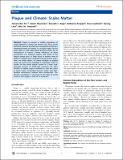Plague and climate: scales matter.

View/
Date
2011-09-01Author
Ben-Ari, Tamara
Neerinckx, Simon
Gage, Kenneth
Kreppel, Katharina
Laudisoit, Anne
Leirs, Herwig
Stenseth, Nils Chr.
Metadata
Show full item recordAbstract
Plague is enzootic in wildlife populations of small mammals in central and eastern Asia, Africa, South and North America, and has been recognized recently as a reemerging threat to humans. Its causative agent Yersinia pestis relies on wild rodent hosts and flea vectors for its maintenance in nature. Climate influences all three components (i.e., bacteria, vectors, and hosts) of the plague system and is a likely factor to explain some of plague's variability from small and regional to large scales. Here, we review effects of climate variables on plague hosts and vectors from individual or population scales to studies on the whole plague system at a large scale. Upscaled versions of small-scale processes are often invoked to explain plague variability in time and space at larger scales, presumably because similar scale-independent mechanisms underlie these relationships. This linearity assumption is discussed in the light of recent research that suggests some of its limitations.
